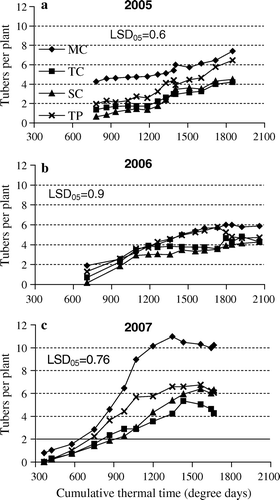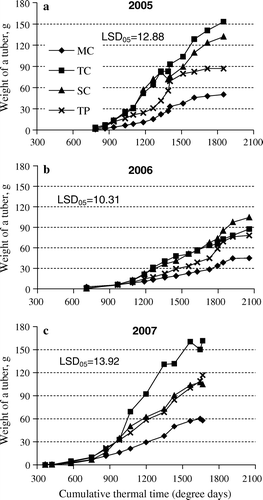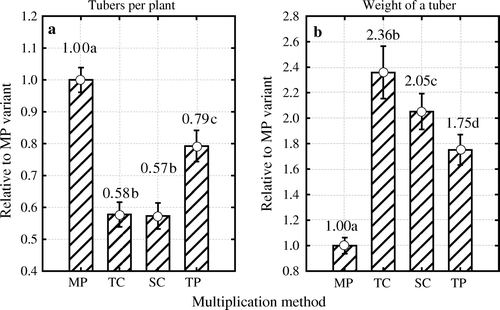Figures & data
Table I. Average temperature, precipitation, and total radiation for the period June–August at the experimental site in Saku.
Figure 1. The number of tubers per plant in 2005 (a), 2006 (b), and 2007 (c), plotted as a moving average over three sample times (over two in the case of the first and the last dates). Multiplication methods: MP – micro plants raised in vitro; TC – tip cuttings; SC – stem cuttings; TP – truncated plants.

Table II. Final differences in examined indicators between plants raised in vitro and those raised from other multiplication methods
Figure 2. Average weight of a tuber in 2005 (a), 2006 (b), and 2007 (c), plotted as a moving average over three sample times (over two in the case of the first and the last dates). Multiplication methods: MP – micro plants raised in vitro; TC – tip cuttings; SC – stem cuttings; TP – truncated plants.

Figure 3. Differences between multiplication methods in the number of tubers per plant (a) and average weight of a tuber (b) determined relative to in vitro micro plants multiplication method over three experimental years and two varieties. Multiplication methods: MP – micro plants raised in vitro; TC – tip cuttings; SC – stem cuttings; TP – truncated plants. Different letters indicate significant differences (p < 0.05) between multiplication methods. Vertical bars denote 0.95 confidence intervals.

Figure 4. Differences between years in relative number of tubers per plant (a) and average weight of tuber (b), calculated relative to micro plants raised in vitro (MP), over all multiplication methods and two varieties. Different letters indicate significant differences (p < 0.05) between years. Vertical bars denote 0.95 confidence intervals.

Figure 5. Differences in the number of tubers per plant (a) and average weight of tubers (b) calculated relative to micro plants in vitro (MP) and averaged over different years and multiplication methods, depending on the variety. Different letters indicate significant differences (p < 0.05) between varieties. Vertical bars denote 0.95 confidence intervals.
